|
|
 |
|
November 29, 2011
…is not wine. That seems absurd on its face, but makes sense when you think it through. A perfect gift is something that the recipient wouldn’t buy for herself or himself, but wine lovers buy wine all the time. Moreover, a great gift is always something really special, but buying a wine that will seem special to a wine lover is going to cost you a lot of money. Additionally, a perfect gift should also be lastingly enjoyable, but wine is generally gone after a single night. Of course, you could buy a wine that needs to be aged for years before it can be enjoyed, but  that seems more like a test than a gift--like the slow-to-mature savings bonds that I used to get as a child from an eccentrically frugal uncle. that seems more like a test than a gift--like the slow-to-mature savings bonds that I used to get as a child from an eccentrically frugal uncle.
Spirits are actually a better choice. In my experience, the vast majority of wine lovers also really enjoy high-end spirits, but are generally too intent on exploring wine from the latest vintage or hottest new producer to buy themselves a terrific bottle of Scotch or Cognac.
Either of these can pass all of the tests that were just failed by wine: The recipient doesn’t likely buy them regularly; special bottles don’t cost all that much; the bottles are much more lasting than wine, and they can be enjoyed right away.
The world is full of wonderful spirits and digestifs like Bourbon and Eau de Vie and Armagnac, but I’d encourage you to focus on Scotch and Cognac because good examples are very complex (like great wine), competitively priced, and widely available.
Great gifts are attuned to the recipient, so think about whether the person whom you’ll be _10_Year_Old-1.jpg) gifting might prefer a Scotch that is “intense and challenging” or “soft and soothing.” Choosing an intense and challenging Scotch whiskey couldn’t be easier: Laphroaig 10 Year-Old ($35 - $40), which is a thrill ride in a bottle driven by rich, smoky, peaty notes. If you’d like to buy something even better in this same style, Lagavulin 16 Year-Old ($65 - 70) is surpassingly intricate and enduringly interesting. gifting might prefer a Scotch that is “intense and challenging” or “soft and soothing.” Choosing an intense and challenging Scotch whiskey couldn’t be easier: Laphroaig 10 Year-Old ($35 - $40), which is a thrill ride in a bottle driven by rich, smoky, peaty notes. If you’d like to buy something even better in this same style, Lagavulin 16 Year-Old ($65 - 70) is surpassingly intricate and enduringly interesting.
On the soft, smooth side, my pick at a more approachable price would be Glenmorangie 10 Year-Old ($35 - $40), a very satisfying Scotch that finishes with a subtle sweetness. A step up in this same style is The Glenrothes 1998, an unusual single “vintage” Scotch ($55), which is very complex but still very smooth in its overall impression.
For Cognac, if you’re looking for something fairly affordable and widely available, it is tough to beat Camus VSOP “Elegance” ($40 - $45), which offers a breadth of aroma and flavor that usually carries a much higher price. At a higher level, Delamain Cognac Grande Champagne “Pale & Dry” ($75 - $85) is marvelously nuanced in a relatively lean, restrained style, whereas Pierre Ferrand Cognac Grande Champagne Reserve ($80 - $90) is rich and full-bodied, with generous flavors, a rounded texture, and an exceptionally smooth finish.
Posted by Michael Franz at 6:08 PM
|
|
November 28, 2011
One good thing about the holidays is that if you listen to the right people you might hear some pretty funny things. Take Dave Barry’s quote about the holiday season for example: “In the old days it was not called the Holiday Season; the Christians called it ‘Christmas’ and went to church; the Jews called it ‘Hanukka’ and went to synagogue; the atheists went to parties and drank. People passing each other on the street would say ‘Merry Christmas!’ or ‘Happy Hanukka!’ or (to the atheists) ‘Look out for the wall!’”
Sooner or later however, you’ll have to stop wasting time listening to people saying funny things and actually start thinking about what you’re going to serve to all the friends and family who are going to stop by for a nibble and a drink. Whether the prospect of the upcoming holiday fills you with anticipation or horror (or perhaps a little of both), the fact is that it’s time to start doing some party planning.
Fortunately, a new book recently appeared that might be helpful. 750 Best Appetizers, From 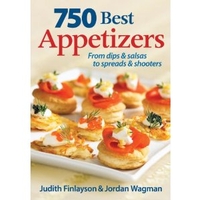 Dips & Salsas to Spreads & Shooters, by Judith Finlayson & Jordan Wagman, offers a wealth of ideas, many of them easy to whip up ahead of time. I’m going to add Roasted Fennel Dip and Tahini-Spiked Beet Spread to my permanent repertoire of party appetizers, and Walnut-Dusted Cheese Balls is another spectacularly wine-friendly little treat. Dips & Salsas to Spreads & Shooters, by Judith Finlayson & Jordan Wagman, offers a wealth of ideas, many of them easy to whip up ahead of time. I’m going to add Roasted Fennel Dip and Tahini-Spiked Beet Spread to my permanent repertoire of party appetizers, and Walnut-Dusted Cheese Balls is another spectacularly wine-friendly little treat.
Walnut-Dusted Cheese Balls
4 oz mascarpone cheese
4 oz Gorgonzola cheese
1 tablespoon minced red onion
1clove garlic, chopped
½ cup finely chopped walnuts
1. In a food processor fitted with metal blade, process mascarpone, Gorgonzola, onion and garlic until smoothly blended. Transfer to a cutting board and shape into 4 balls, each about 1 ½ inches in diameter.
2. Spread walnuts on a work surface. Roll balls until well covered. Chill for at least 3 hours or up to 2 days, until nicely firm. Spread on plain crackers
 My first choice of what to pour to accompany the cheese balls, or for that matter to strike the right note with just about any savory hors d’oeuvre during the holiday season, is sparkling wine. You can fill the flutes with fizz from virtually every wine-producing country in the world, for whatever price your wallet can handle. Here are some ideas to get you started, ranging from Argentina to Spain, and from $10 to $230: My first choice of what to pour to accompany the cheese balls, or for that matter to strike the right note with just about any savory hors d’oeuvre during the holiday season, is sparkling wine. You can fill the flutes with fizz from virtually every wine-producing country in the world, for whatever price your wallet can handle. Here are some ideas to get you started, ranging from Argentina to Spain, and from $10 to $230:
Argentina: Bianchi Extra Brut ($30).
Australia: Paringa Sparkling Shiraz ($13).
California: Gloria Ferrer “Royal Cuvée” Brut 2004 ($32); J Brut Rosé ($28); Hacienda Brut ($13); Douglas Hill Brut ($10).
France: Louis Roederer Champagne “Cristal” 2004 ($230); Gustave Lorenz Crémant d’Alsace ($25); Pierre Chainier Cremant de Loire “Rosé Séduction” Brut $13); Lucien Albrecht Crémant d’Alsace ($20); Paul Rémy Brut ($11).
Italy: Casa Nova Prosecco di Treviso ($18); Valdo Nerello Mascalese Brut Rosé ($14).
Spain: Paul Chenau “Lady of Spain” Cava ($13); Segura Viudas Brut Reserva ($10).
Posted by Marguerite Thomas at 10:46 AM
|
|
November 25, 2011
Creators SyndicateThe beauty of the holiday season, in my humble opinion, is the sheer scope of the Epicurean possibilities. The season of festivity stretches on for several weeks and gives me an excuse to indulge in myriad adult beverages of great import, and we end it all with firm resolve to undo the damage to the waistline in the coming year.
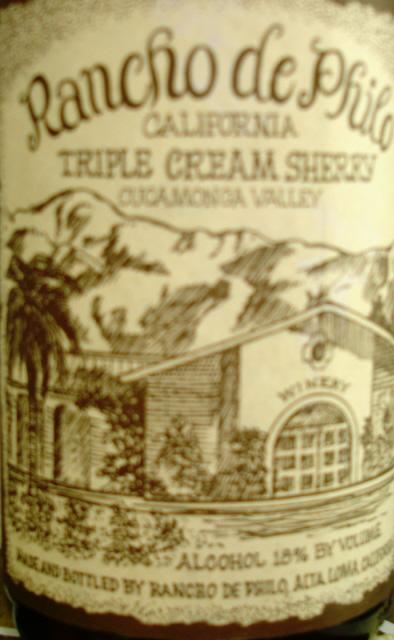 It is at this time of year that I permit myself the sinful pleasures of decadent ports and sherries, exquisite single-malt scotch, and the occasional snifter of cognac or Armagnac, libations that I generally save for special occasions. It is at this time of year that I permit myself the sinful pleasures of decadent ports and sherries, exquisite single-malt scotch, and the occasional snifter of cognac or Armagnac, libations that I generally save for special occasions.
This year, I am especially focused on the dessert wines in my cellar, for it has been an exceptional time for these delicious but often misunderstood gems. It is my sense that our wine culture has evolved in recent years and that more wine enthusiasts are coming around to the proposition that there is a time and place for sticky sweet wine. Twice this year, I have witnessed professional wine judges vote dessert wines the top award at a major international wine competition.
In April, the Rancho de Philo Triple Cream Sherry ($35) won the honor as Wine of the Year at the 28th annual San Diego International Wine Competition. In September, Inniskillin's 2007 Vidal Icewine ($60) received the same accolade at the third annual Sommelier Challenge. Both dessert wines triumphed over prestigious and ostensibly more popular dry table wines.
Of course, their remarkable successes in those two wine shows begged the questions: When do you drink those wines, and with what?
The time to drink them is now. What to drink them with is a matter of personal preference. I plan to serve the Inniskillin ice wines I've stashed with savory cheeses. To my palate, these wines are so sweet they are a bit of overkill when served with a dessert course. You can do it, and you may well come up with an exceptional match, but runny, smelly cheeses make the best match for me. Besides the winning Vidal ice wine, Inniskillin also won Platinum awards with its 2006 Vidal Gold Icewine ($77) and its 2007 Riesling Icewine ($80).
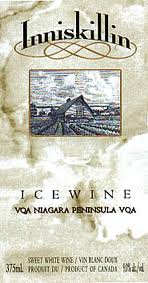 The Inniskillin ice wines are made in the Niagara Peninsula region in Ontario, Canada, from grapes, as the name suggests, that have frozen on the vine before they were harvested. This technique concentrates the sugars and flavors, and produces intensely sweet and flavorful dessert wines that are much prized by connoisseurs. Note that the prices are for 375 ml bottles and that the alcohol by volume of the ice wines is below 10 percent for each, making these wines easy to enjoy after a big holiday feast because they don't pack huge alcohol wallop. The Inniskillin ice wines are made in the Niagara Peninsula region in Ontario, Canada, from grapes, as the name suggests, that have frozen on the vine before they were harvested. This technique concentrates the sugars and flavors, and produces intensely sweet and flavorful dessert wines that are much prized by connoisseurs. Note that the prices are for 375 ml bottles and that the alcohol by volume of the ice wines is below 10 percent for each, making these wines easy to enjoy after a big holiday feast because they don't pack huge alcohol wallop.
Rancho Cucamonga's Triple Cream Sherry has been one of the most consistent winners in my nearly 20 years of wine competition experience.
It is made with mission grapes, using the solera method that is familiar in southern Spain, and the wine is fortified, coming in at 18.5 percent alcohol by volume. I sometimes serve it with creme brulee or flan to pick up on its seductive spiciness. It is also good with mild cheeses or candied nuts, but more often than not I simply sip it as a digestivo in front of the fire after dinner.
Posted by Robert Whitley at 1:54 PM
|
|
November 21, 2011
In 2011 my imagination is set not on a particular wine, but on a specific region. This year’s Thanksgiving feast is going to focus on the wines and food of Alsace, which for many of us is France’s most rewarding gastronomic region.
We’ll begin the meal with oysters. Of course this isn’t necessarily an Alsace specialty, but in my opinion all festive meals should begin with an array of oysters shimmering icily in their  half-shells. We’ll pour Lucien Albrecht Crémant d’Alsace Brut Rosé with the oysters. You might suggest something more acidic, something leaner to go with the bivalves but I like the rosé because it’s pretty, because it has a lovely mousse (and bubbles are the most festive way to begin any holiday), and because its fragrance and fresh flavors will complement the sea-scented, saline-tinged oysters. I also like that this Crémant costs $20, a reasonable indulgence for such high quality tipple. half-shells. We’ll pour Lucien Albrecht Crémant d’Alsace Brut Rosé with the oysters. You might suggest something more acidic, something leaner to go with the bivalves but I like the rosé because it’s pretty, because it has a lovely mousse (and bubbles are the most festive way to begin any holiday), and because its fragrance and fresh flavors will complement the sea-scented, saline-tinged oysters. I also like that this Crémant costs $20, a reasonable indulgence for such high quality tipple.
Next we’ll dig into a tarte flambée, a thin crust typically topped with crème fraiche, finely sliced onions, and lardons baked until it is a crispy, succulent amalgam of textures and tastes. Domaine Weinbach Sylvaner Reserve should be terrific with it since the wine is just delicate enough to complement the dish, and it also has nuances of smoke and apple that will embrace the bacon-like lardons.
We need a blowout but affordable wine to go with the choucroute garni because there will be no holds barred with the dish, whose mélange of sauerkraut, sausages, pork and goose is one of the world’s great culinary triumphs. I think Marc Kreydenweiss Riesling should do the trick here. With impressive fruit flavors and a subtle hint of petrol, it is both dry and expansive, and and lingers long on the palate.
We may have to go for a walk in the park before settling down to the cheese course, but no Alsace-themed meal is complete without an oozy, stinky, runny Munster. Domaines 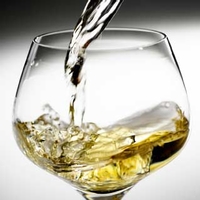 Schlumberger Grand Cru Gewurztraminer Kessler will have enough depth and weight to seesaw with the cheese, plus an intense aroma of its own to keep the balance going. Schlumberger Grand Cru Gewurztraminer Kessler will have enough depth and weight to seesaw with the cheese, plus an intense aroma of its own to keep the balance going.
Since all the wines so far are judiciously priced (none, I think are much over $30, and most are closer to $20), maybe we can live it up with dessert and pour Zind-Humbrecht Riesling Vendange Tardive (about $140) to go with a simple apricot tart. The wine’s layered spice, citrus, and dried fruit resonate with the apricots, and its voluptuous texture is fine partner for the rich buttery crust.
Is this really the meal I’ll be indulging in on Thanksgiving Day? Nah. I’ll be forking up turkey and the works, including sweet potatoes with marshmallows (sigh--some traditions defy eradication). Furthermore, sociable glutton that I am, I’ll be wholeheartedly loving every moment of the day--except for that tiny corner of my imagination that will have meandered off to Alsace.
Posted by Marguerite Thomas at 8:44 AM
|
|
November 19, 2011
I was sorely tempted to flout tradition next week and ditch the traditional turkey in favor of roasting a goose, which I vastly prefer. The very best turkey I’ve ever had was really just okay in my opinion, whereas a well-roasted goose can be fabulous. Moreover, my rebellious inclination was encouraged by the fact that I’d only be cooking for three people, negating the 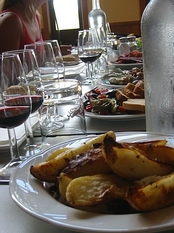 only shortcoming of a roast goose, which is that it doesn’t provide lots of meat. only shortcoming of a roast goose, which is that it doesn’t provide lots of meat.
Then I reflected on the fact that the other two people present would be my 90 year-old father and my 89 year-old mother, who are wonderfully agreeable people but also quite traditional about their holidays, and hence likely to be disappointed to miss a turkey on Thanksgiving.
At which point I chickened out, opting for a turkey yet again this year.
[Just for the record, for fear that you’ll think I’m such a jerk that nobody wants to be with me on Thanksgiving, my siblings and their kids will all be off to see their in-laws this year, and my wife happens to be one of very few people required to work on Thanksgiving day. She’s Managing Producer of public radio’s The Splendid Table, and if you are a little unsure of your cooking skills for this Big Meal, you should check out host Lynne Rosetto Kasper’s live, nation-wide, two-hour broadcast of “Turkey Confidential,” which is full of useful advice and hilarious phone calls from freaked-out cooks. And by the way, please excuse the shameless nepotism involved in this digression.]
Anyway, having chickened out on the bird of choice, you can be damned sure that I won’t be chickening out on the wines I’ll be serving this year. None of the usual suspects for me! No Pinot Noir, by Jove, and no bloody way, Beaujolais. No Gewurztraminer either. The world offers plenty of exciting, un-customary wines that can prove very successful for this utterly customary meal, so here are seven whites and seven reds that you should consider:
Whites:
Chasselas from Switzerland
Pinot Blanc from Alsace, Austria, or Oregon, or Pinot Bianco from Friuli
Garnacha Blanca / Grenache Blanc from Spain’s Catalonia or France’s Rhône
Moschofilero or Roditis from Greece
Savennières from the France’s Loire Valley
Verdelho from Australia
Grüner Veltliner from Austria
Reds:
Nero d’Avola from Sicily
Montepulciano from Italy’s Abruzzo
Garnacha from Spain’s Navarra
Dolcetto or Dogliani (a Dolcetto specialty zone) from Piedmont in Italy
Agiorghitiko from Greece
Cariñena from Aragón in Spain
Zweigelt from Austria
All fourteen of these wines will perform very well at your Thanksgiving table, and 13 out of the 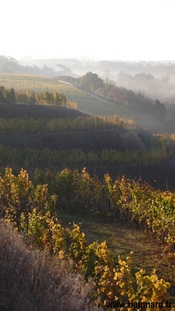 14 could be purchased for less than $20. Indeed, given the fact that a typical Thanksgiving meal involves a lot of variation in flavors and textures, relatively simple wines tend to perform especially well, so you’d be well advised to purchase reasonably priced examples of these wines. That will minimize the chances that you’ll get an oaky rendition. 14 could be purchased for less than $20. Indeed, given the fact that a typical Thanksgiving meal involves a lot of variation in flavors and textures, relatively simple wines tend to perform especially well, so you’d be well advised to purchase reasonably priced examples of these wines. That will minimize the chances that you’ll get an oaky rendition.
The 14th wine that would likely cost you more than $20 is the Savennières, which is the world’s premier dry Chenin Blanc from a tiny appellation that is fortuitously sited on a little bend along the Loire River. It would be sensational with most preparations of Thanksgiving dinner, but if you can’t pony up for a bottle, you could substitute a Vouvray (also from the Loire) or a Chenin Blanc from South Africa and probably be very happy with the outcome.
So there you have it…there’s no excuse for drinking the same old wine along with that same old meal!
Posted by Michael Franz at 10:58 AM
|
|
November 18, 2011
I have to admit that I’m strictly a traditionalist when it comes to celebrating Thanksgiving, our most festive holiday. In fact, I’m a traditionalist in most things related to food and wine. I couldn’t imagine not having roast turkey on Thanksgiving. And for at least 30years, I always start off this special day with Champagne
Since this is a day that we usually celebrate with lots of family and friends, I save my Prestige Cuvée Champagnes for other occasions. But I always serve a very good NV Brut Champagne, such as Charles Heidsieck Brut Réserve, which has a high percentage (up to 40 percent) of older vintages in its blend. I prefer very dry NV Bruts, and so I often will choose  Ayala, Bruno Paillard Réserve Privée Blanc de Blancs, or Jacquesson as my apéritif Champagne. Ayala, Bruno Paillard Réserve Privée Blanc de Blancs, or Jacquesson as my apéritif Champagne.
With the roast turkey breast and vegetables, I prefer a white wine. White Burgundies, such as Premier Cru Puligny-Montrachets or Premier Cru Meursaults , are ideal with smaller gatherings, but these wines are too expensive to serve when there are lots of people. Some excellent, dry, flavorful whites from the Alto Adige region in northeastern Italy are often my choice with turkey breast. Three dry whites that I particularly enjoy are Abbazia di Novicella’s Kerner, Tiefenbrunner’s fantastic Müller-Thurgau (from its Feldmarschall Vineyard), and Hofstätter’s Gewürztraminer, “Kolbenhof.” All of these wines have lots of flavor, but will not overwhelm the turkey.
With turkey drumsticks and thighs, I enjoy red Burgundies and Sonoma Coast Pinot Noirs. Also a good cru Beaujolais, such as Fleurie or Julienas, can work well. These wines are all rather low in tannin, and are fine complements to turkey. Bordeaux and Cabernet Sauvignon are just too tannic to serve with turkey, in my opinion.
Lighter-bodied red Burgundies, such as Volnay Premier Crus from Domaine du Marquis d’Angerville, would be outstanding with the turkey. If you want to stay with American wines, I’d choose the wonderfully balanced Pinot Noirs from the Sonoma Coast, such as any wine from 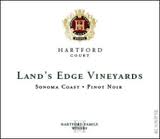 Littorai, or the Sonoma Coast bottlings of Hartford Court or Williams Selyem. Two excellent Sonoma Coast Pinot Noir wineries making superb wines are Cobb Wines and Hirsch Vineyards--but they are small and their wines might be difficult to find. Littorai, or the Sonoma Coast bottlings of Hartford Court or Williams Selyem. Two excellent Sonoma Coast Pinot Noir wineries making superb wines are Cobb Wines and Hirsch Vineyards--but they are small and their wines might be difficult to find.
With dessert, I enjoy Taylor Fladgate’s ports, such as the 20 year-old Tawny, or the First Estate Vintage Character Port. The other port I recommend is Dow’s 20 year-old Tawny. Both of these producers specialize in dryer-styled ports. Not that port is ever dry, but Taylor and Dow are never cloyingly sweet.
I am a firm believer in having a digestif after Thanksgiving dinner, so that you can wake up the next day not suffering from over-indulgence. For me, Underberg, a German digestif that comes in small, one-shot bottles, works best. But the Italian standby, Fernet Branca, also is a very good digestif.
Happy Thanksgiving to All!
Posted by Ed McCarthy at 11:47 AM
|
|
November 16, 2011
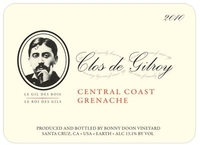
Creators Syndicate
They say hindsight is 20-20. Let's hope so. After 20 years of penning this column, I've filed at least 20 columns for various publications with recommendations for the Thanksgiving feast.
As you might imagine, the challenge every year is to produce a new approach to a traditional holiday in which the variables are actually constants. Most traditional Thanksgiving dinners will feature turkey, and it doesn't really matter all that much that some will roast it, others will deep-fat fry it and some will even use the grill.
I would tell you the same no matter: The bird is versatile — either red wines or white wines are perfectly acceptable, and I tend to shy away from reds that are heavy or exhibit aggressive tannins. Given that the typical traditional Thanksgiving dinner is well attended by family and friends, cost could be something to factor in. And the nature of the feast, which mixes sweet and savory dishes side by side, allows for wines that are fruity or slightly sweet, as long as they are well balanced.
So this year I've decided to do a 20-20 Thanksgiving. That is to say, I have looked back through my tasting notes from the past year and picked out wines that I believe are well suited for the Thanksgiving task. And to further promote the 20-20 theme, I've chosen 20 wines that retail for $20 or less.
Let the feasting begin.
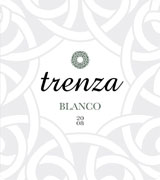 Trenza 2009 'Blanco,' Edna Valley, ($20) -- Trenza's 'Blanco' is a shining example of the potential for unusual grape varieties to do well in many of California's cool, coastal appellations. The grapes are unusual only in the sense that traditionally they have not been widely planted, if planted at all, in this country. This is a 50-50 blend of albarino (the delicious white from the Rias Baixas district of Galicia in western Spain) and grenache blanc, a staple of the white wines of the southern Rhone Valley of France. The albarino provides the zing, the grenache blanc the heft. It's a lovely combo that shows aromas of red citrus, such as tangerine, and crisp pear. There is a flinty, edgy minerality throughout. I absolutely loved it. Rating: 94. Trenza 2009 'Blanco,' Edna Valley, ($20) -- Trenza's 'Blanco' is a shining example of the potential for unusual grape varieties to do well in many of California's cool, coastal appellations. The grapes are unusual only in the sense that traditionally they have not been widely planted, if planted at all, in this country. This is a 50-50 blend of albarino (the delicious white from the Rias Baixas district of Galicia in western Spain) and grenache blanc, a staple of the white wines of the southern Rhone Valley of France. The albarino provides the zing, the grenache blanc the heft. It's a lovely combo that shows aromas of red citrus, such as tangerine, and crisp pear. There is a flinty, edgy minerality throughout. I absolutely loved it. Rating: 94.
Quivira 2010 Sauvignon Blanc, Fig Tree Vineyard, Dry Creek Valley ($18) — I was once a staunch admirer of the Quivira wines, but went off the reservation when the wines started to push the alcohol levels beyond my level of tolerance. So it was a joy to taste a Quivira wine I could love again, and that would be this sensational sauvignon from the 2010 vintage. The nose is inviting ripe figs and red citrus, flavors that are delivered on the palate. Well balanced and fresh, the palate shows a hint of richness that creates a lovely harmony with the underlying acidity. Rating: 93.
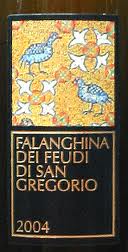 Feudi di San Gregorio 2009 Falanghina, Campania, Italy ($15) — The whites from this part of southern Italy are prized for their earthy minerality, rich viscosity and balancing acid. These characteristics would seem incompatible with the hot climate, but that is the miracle of Campania. Greco di Tufo and Fiano di Avellino are well regarded and among the most important white wines in all of Italy. Falanghina doesn't enjoy such a lofty reputation, but its popularity is surging, no doubt because of the price differential. When it comes to quality and pleasure of drinking, however, there isn't such a huge difference. The '09 from Feudi di San Gregorio exhibits lush tropical fruits, a refreshing undercurrent of citrus and green apple, with a hint of honey and white flower on the finish. Rating: 93. Feudi di San Gregorio 2009 Falanghina, Campania, Italy ($15) — The whites from this part of southern Italy are prized for their earthy minerality, rich viscosity and balancing acid. These characteristics would seem incompatible with the hot climate, but that is the miracle of Campania. Greco di Tufo and Fiano di Avellino are well regarded and among the most important white wines in all of Italy. Falanghina doesn't enjoy such a lofty reputation, but its popularity is surging, no doubt because of the price differential. When it comes to quality and pleasure of drinking, however, there isn't such a huge difference. The '09 from Feudi di San Gregorio exhibits lush tropical fruits, a refreshing undercurrent of citrus and green apple, with a hint of honey and white flower on the finish. Rating: 93.
Tangent 2009 Albarino, Paragon Vineyard, Edna Valley ($17) — The early albarino efforts from Tangent were certainly plausible expressions of the grape, but recently the program seems to have found another gear. Albarino, originally grown in the cool, wet region of Rias Baixas in northwest Spain, seems to be thriving in the cool, coastal vineyards of the Edna Valley, where the Paragon vineyard is situated. This vintage offers aromas of green and red citrus, with notes of tangerine and lime, as well as a hint of the minerality that inspires so many fans of albarino. Rating: 91.
Eberle Winer 2010 Muscat Canelli, Paso Robles ($14) — Don't be put off by the fact that this refreshing white has a bit of residual sugar and is described by the winemaker as "semi-sweet." There is a place for it at the dinner table, or even as an aperitif on a warm summer day. Muscat made in the style of the Eberle Muscat Canelli is light and refreshing, well balanced,and a perfect foil for desserts that aren't too sweet, or those that are fruit-based. The flavors and aromas show hints of floral, citrus, ripe melons and spice. Rating: 91.
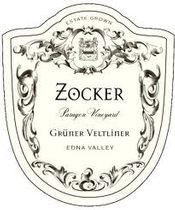 Zocker 2010 Gruner Veltliner, Paragon Vineyard, Edna Valley ($18) — Winemaker Christian Roguenant is a native of Burgundy and well regarded for his work in California with pinot noir and chardonnay. Less well known are his accomplishments with crisp white wines such as albarino and this gruner veltliner. Gruner, a steely white grape more typically seen in Austria, is relatively new to California viticulture. Zocker's is planted in the cool Edna Valley, near San Luis Obispo on California's Central Coast, within spitting distance of the Pacific Ocean. It is bone dry and minerally, with firm acidity and subtle hints of citrus fruits and tart apples. Rating: 91. Zocker 2010 Gruner Veltliner, Paragon Vineyard, Edna Valley ($18) — Winemaker Christian Roguenant is a native of Burgundy and well regarded for his work in California with pinot noir and chardonnay. Less well known are his accomplishments with crisp white wines such as albarino and this gruner veltliner. Gruner, a steely white grape more typically seen in Austria, is relatively new to California viticulture. Zocker's is planted in the cool Edna Valley, near San Luis Obispo on California's Central Coast, within spitting distance of the Pacific Ocean. It is bone dry and minerally, with firm acidity and subtle hints of citrus fruits and tart apples. Rating: 91.
Clos de Gilroy 2910 Grenache, Central Coast ($18) — The great red wines of the southern Rhone, particularly Chateauneuf-du-Pape and Gigondas, owe a good deal of their charm and appeal to the less-well-known grenache grape. In this his latest Clos de Gilroy Grenache, winemaker Randall Grahm captures the very essence of grenache, the succulent red-fruited aromas laced with minerality, the juicy palate, the hints of freshly ground black pepper, and the lip-smacking length and finish you will find in so many of the better wines of the southern Rhone. Rating: 90.
Skalli 2009 Cotes-du-Rhone 'Les Rabassieres', France ($15) — The problem, really the only problem, with Cotes-du-Rhone is that it can be anything. Skalli's Les Rabassieres resides in the upper echelon, where the wines have more substance. It is heavy on grenache at 60 percent, with the remainder of the blend given to syrah and Mourvedre. This was a superb vintage in the Rhone Valley, with a late-summer heat wave that pushed the grapes to full ripeness heading into the tricky fall weeks of harvest. The wine exhibits lovely aromas of sweet red fruits such as raspberry, currant and strawberry, with a hint of spice, and savory notes of dried herbs and garrigue. It is full and supple in the mouth, with sweet, smooth tannins and good balance despite palate weight that might surprise. Rating: 90.
 Calera 2010 Chardonnay, Central Coast ($18) — Winemaker Josh Jensen has been at this for quite some time (the label says this is the 35th anniversary vintage) and no doubt has reliably outstanding sources for the grapes that don't grow on his Mt. Harlan estate. How else to explain the remarkably (and consistently) high quality of Calera's "Central Coast" chardonnay? This vintage has a little something for everyone, with a creamy palate, lovely aromas of lemon custard and ripe pear, and a long, lingering finish that begs another sip. Rating: 90. Calera 2010 Chardonnay, Central Coast ($18) — Winemaker Josh Jensen has been at this for quite some time (the label says this is the 35th anniversary vintage) and no doubt has reliably outstanding sources for the grapes that don't grow on his Mt. Harlan estate. How else to explain the remarkably (and consistently) high quality of Calera's "Central Coast" chardonnay? This vintage has a little something for everyone, with a creamy palate, lovely aromas of lemon custard and ripe pear, and a long, lingering finish that begs another sip. Rating: 90.
Rodney Strong Vineyards 2009 Chardonnay, Estate, Chalk Hill ($20) — For the price, the Chalk Hill Estate from Rodney Strong is likely one of the finest California chardonnays money can buy. When tasted recently, it was showing bright acidity with notes of citrus and pear fruit. Winemaker Rick Sayre descibed it as "tightly wound" because, I surmised, it seems austere when tasted beside the winery's Reserve Chardonnay. The trajectory is good, however, and I am certain this wine will soften and its depth and fruit complexity will emerge after another six to nine months in the bottle. Rating: 90.
Dry Creek Vineyard 2010 Sauvignon Blanc 'Fume Blanc', Sonoma County ($12) -- Yes, indeed, Dry Creek Vineyard does sauvignon blanc, and very well at that. Winery founder David Stare made sure of that long before anyone thought sauvignon was a viable commercial grape in California. So DCV had a passion for sauvignon then, and still does. The basic 2010 Fume Blanc (100 percent Sauvignon) is a classic, exhibiting intense aromas of lemongrass and dried herbs, passionfruit and grapefuit, with exquisite balance, modest alcohol (13.5 percent) and a lingering finish. Rating: 90.
Tapena 2009 Garnacha, Tierra de Castilla, Spain ($10) — This grape variety is more widely known as grenache when grown in France and other parts of the world. No matter how you say it, delicious is the most obvious descriptor for this particular wine. This vintage of Tapena Garnacha exhibits lush red-fruited aromas and supple tannins, making this an inviting and easy-to-drink red built for immediate enjoyment, no additional cellaring needed. Rating: 90.
Li Veli 2007 Salice Salentino, 'Pezzo Morgana', Puglia, Italy ($20) — The premier wine grape of Puglia is negroamaro, and Li Veli's Pezzo Morgana Salice Salentino is 100 percent negroamaro from the Li Veli estate. The '07 is a robust wine that delivers rich aromas of plum and cherry, with an oily texture on the palate that is typical of reds from this region. The tannins are nicely integrated, but exhibit a sneaky grip on the finish. Serve it with grilled red meats. Rating: 90.
Coltibuono 2009'RS' Chianti Classico, Tuscany, Italy ($15) — Coltibuono has a long tradition of exceptional quality at a fair price, and it's Chianti Classico RS is a good example. It's supple and fresh, with loads of bright red fruit, firm acid, and good weight and length on the palate. It shows plenty of sophistication and finesse for a wine that is meant to be consumed young, and it's definitely food friendly. Rating: 89.
Alta Luna 2009 Vigneti delle Dolomiti IGT 'Phases', Trentino, Italy ($14) — Phases is an eclectic blend of two native grape varieties — teroldego and lagrein — with merlot. Because of the cool climate in the foothills of the Alps, the native grape varieties can sometimes fail to ripen fully, producing lackluster reds at best. The early ripening merlot grape is a clever safeguard against a poor vintage. The '09 Phases hits on all cylinders, though, exhibiting the red-fruited characteristics of the native grapes and the darker fruit aromas of merlot. The wine is nicely structured, with smooth tannins and firm acidity. Rating: 88.
Franciscan 2009 Sauvignon Blanc, Napa Valley ($17) —This is a largely tank-fermented sauvignon that delivers aromas of grapefruit, lime and passionfruit typical of cooler climates, so that leads me to believe the vineyard sources are either located in the southern Napa Valley or on the cooler western side of the valley, where the vineyards are often shaded from the afternoon sun. That would also explain the pleasing mineral note that I find attractive. Rating: 88.
Vina Zaco 2008 Tempranillo, Rioja, Spain ($15) — This is a decidedly bright, fresh, modern Rioja from one of the oldest, most important areas of the district. Vina Zaco is from Bodegas Bilbainas, which has several hundred acres in and around the village of Haro in the Rioja Alta, which is where the business of Rioja wine firmly established itself more than 100 years ago. This is a fruit-forward red that fairly shouts "raspberries" as it is being poured into the glass. It's fresh and vibrant, with a hint of spice from the nine months of barrique aging prior to bottling. Rating: 88.
Torres 2010 'Vina Esmeralda', Catalonia, Spain ($15) — A blend of moscatel and gewurztraminer, Torres' Vina Esmeralda is a fresh breeze on a warm Mediterranean day. The nose is scented with honeysuckle and rose petal, followed by flavors of tropical fruit and spice. Not only is it refreshing, it's low alcohol, too, at 11.5 percent. Rating: 88.
Clayhouse 2010 'Adobe Pink,' Central Coast ($14) — The first obligation of a rose wine is to refresh. Check. The second is to show plenty of fruit without going to the bubblegum side of the flavor spectrum. Check. It shows pretty aromas of strawberry and spice, with hints of dried herbs. The blend is Mourvedre, syrah and cabernet, and the bottom line is that it's delicious, inexpensive and refreshing. Rating: 87.
Cancelli 2009 Rosso di Toscana IGT, Italy ($10) — This blend of sangiovese and syrah is unusual for Tuscany, especially in the Chianti Classico district where the mother winery, Coltibuono, is located, but it works, and that's all that really matters.. Aromas of cherry and spice are pure sangiovese, as is the firm acid structure. The syrah lends a note of blueberry. Cancelli is fermented in stainless steel and aged in the bottle, so it never sees the inside of a barrel. It is fresh, clean and fruity. Rating: 87.
Posted by Robert Whitley at 6:24 PM
|
|
November 13, 2011
There are many reasons why my colleagues and I accept invitations to be judges in wine competitions (it certainly isn’t the pay, which at best is a modest honorarium). One of the main explanations for why we’re willing to travel considerable distances for the privilege of spending two or three days in a hotel conference room or undistinguished building at a fairgrounds somewhere, is for the opportunity to hone our palates as we taste a variety of different wines from around the world. There is also the occasional thrill of discovering a wine, producer and/or wine region we might not otherwise encounter. And another powerful attraction is the conviviality involved in being with old friends and colleagues (and meeting new ones) and sharing with them, in a very specific context, a mutual passion for wine.
For the uninitiated, however, I feel obliged to point out that judging wines can be many things--interesting, educational, fun--but one thing it generally isn’t is easy.
Let me walk you through a typical first-morning of most wine competitions. The action usually starts promptly at 8 or 9 am, which can be a hardship for judges who have been out partying 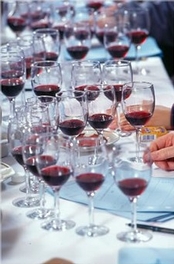 the night before (I am not one of them--honest). Okay, you’ve just gulped down your final sip of breakfast coffee as you take your assigned seat and gaze at the fifteen glasses of, let’s say, Chardonnay arranged in front of you. Generally speaking you’ve not been provided with clues as to the wines’ appellations or countries of origin, their various vintage dates or price points. Faced with this sea of yellowish liquid quivering in fifteen glasses, you may feel a wave of panic flutter through your gut: How will I be able to distinguish one wine from another, doesn’t all Chardonnay taste kind of alike, and why did I drink that third cup of java when everyone knows coffee dulls the taste-buds? the night before (I am not one of them--honest). Okay, you’ve just gulped down your final sip of breakfast coffee as you take your assigned seat and gaze at the fifteen glasses of, let’s say, Chardonnay arranged in front of you. Generally speaking you’ve not been provided with clues as to the wines’ appellations or countries of origin, their various vintage dates or price points. Faced with this sea of yellowish liquid quivering in fifteen glasses, you may feel a wave of panic flutter through your gut: How will I be able to distinguish one wine from another, doesn’t all Chardonnay taste kind of alike, and why did I drink that third cup of java when everyone knows coffee dulls the taste-buds?
But then you settle down and start swirling, sipping, spitting, and evaluating the wines. There’s little time to dawdle over any of them, let alone take meaningful notes, for soon those first glasses will be cleared away and immediately replaced by, probably, another dozen or so Chards and then another. When all the Chardonnay flights are finished you might be faced next with 64 Cabernets spread out over three or four flights and then, perhaps, 4 or 5 glasses of wine categorized as “other whites”: A couple of Seyval Blancs, a Vidal, and a Moschofilero from Greece, for example. And you’re expected to make judicious sense out of this vinous confusion!
Time to break for lunch (you are famished! What is it about sipping and spitting that induces this kind of hunger?)
After chowing down for an hour or so it’s back into the chilly room (the wines need to be kept cool) for a full afternoon that might focus on anything from Albariño to Zinfandel, including wine made from blueberries, vitis labrusca or mangoes.
By the end of the day’s session everyone’s teeth have been stained a zombie-ish purple. You all have glazed eyes, throbbing tongues and sore gums (from all those high-acid and/or tannic wines), a stiff back from 12 hours of sitting, and an insane desire to compare notes with other judges: “Our panel had to taste 72 Merlots!” “We had a delicious Niagara that I actually gave a gold medal to.” “What’s with all the California Pinot Noirs that taste like Syrah?”
In some competitions each flight is discussed with other panel members as soon as individual scores are recorded (judges are almost always instructed to make up their own mind before comparing notes with fellow panelists); other competitions discourage discussion. Both systems have advantages and disadvantages, but one benefit of discussions is that they can be a valuable experience for participants who are open-minded enough to really listen to what colleagues might have to say (pro or con) about a given wine.
One of the most rewarding aspects of dealing with experienced wine professionals, whether they are journalists, sommeliers, educators or vintners, is the diverse and wide range of experience they may bring to the table, the level of proficiency, and the general lack of egomania (prima donnas and non-negotiaters are seldom invited back.) Of course this is wine, not world peace, but still it’s refreshing to be reminded that adults are capable of gathering together and behaving like civilized human beings who are serious about what they’re doing but still have a sense of humor (some of the best jokes I’ve heard are at wine competitions, usually somewhere between the Merlots and the Rieslings).
The most recent competition I’ve been involved in was the 17th annual International Wines for 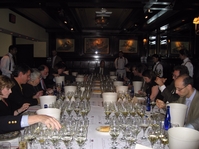 Oysters competition held earlier this month at the legendary Old Ebbitt Grill in Washington DC. Each judge was poured the same twenty wines to evaluate (they’re tasted blind, of course), and collectively we slurped down hundreds of oysters as we assessed every wine--not on its own merits, but on its affinity for oysters. (This is one competition, by the way, where judges do not communicate until after the results are announced). I’ve participated in almost every one of the Old Ebbitt competitions, and since, as usual Sauvignon Blanc dominated the field, this time it was no real surprise when, after the votes were tallied, the winning wine was revealed to be a Sauvignon Blanc from New Zealand. Even with the annual input of a handful of new judges, we inevitably reach the conclusion that zingy, lean and mean white wine is the best partner for raw oysters. Oysters competition held earlier this month at the legendary Old Ebbitt Grill in Washington DC. Each judge was poured the same twenty wines to evaluate (they’re tasted blind, of course), and collectively we slurped down hundreds of oysters as we assessed every wine--not on its own merits, but on its affinity for oysters. (This is one competition, by the way, where judges do not communicate until after the results are announced). I’ve participated in almost every one of the Old Ebbitt competitions, and since, as usual Sauvignon Blanc dominated the field, this time it was no real surprise when, after the votes were tallied, the winning wine was revealed to be a Sauvignon Blanc from New Zealand. Even with the annual input of a handful of new judges, we inevitably reach the conclusion that zingy, lean and mean white wine is the best partner for raw oysters.
What was new in 2011 was that although many of the runners-up came from well-known New Zealand producers (Villa Maria, Nautilus, Goldwater, Vavasour) the number-one wine was from Jules Taylor (Marlborough, NZ), a label unfamiliar to many of us. And this is exactly one reason why competitions are good for everyone: Judges learn about a relatively obscure wine and pass the word along to the wine drinking public.
The critical feature of wines that win awards in a competition is that they have been appraised by a group of experienced tasters rather than an individual palate. While it’s certainly true that a single respected wine critic’s opinion can guide us towards making relatively informed purchases, winning wines in reputable competitions have been vetted and approved by a consensus of skilled tasters. Which is why I can advise you with relative confidence to seek out Jules Taylor Sauvignon Blanc the next time you serve oysters (or, for that matter shrimp or most other shellfish). If you happen to be one of those people who haven’t jumped on the NZ Sauvignon bandwagon, I’d recommend with equal enthusiasm “Grooner,” a 2010 Gruner Veltliner from Niedeosterreich, Austria. I ranked it among my top three wines at the Old Ebbitt Competition.
Posted by Marguerite Thomas at 2:03 PM
|
|
November 9, 2011
If you’re already a fan of manga (Japanese comic books) I don’t need to tell you how much fun they can be. If you are not yet familiar with manga, and especially if you love wine, Drops of God offers an entertaining way to learn more about both wine and a madcap new literary 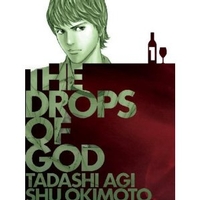 genre. genre.
The basic plot of this series is wacky enough: young Shizuku Kanzaki, son of a renowned wine critic, must compete against his adoptive brother (a rising wine critic himself) for their late fathers’ estate. As his will specifies, the two young men must identify and describe a certain twelve bottles of wine, including some of the world’s most treasured labels from France, California and Italy. As the competition between the rivals heats up we too learn about such things as how Burgundian vineyards are ranked, and how its wines are produced.
The plotline is sprinkled with helpful details about reading labels, terroir, and much more, including decanting: At the beginning of the book Kanzaki doesn’t yet know much about wine but he is already a master at decanting, having been taught the basics at a young age by his father. For example, after a 1990 Domaine de la Romanée Conti is uncorked, “His almost divine decanting released that stiff chained-up Richbourg and turned it into a field of flowers blowing in full glory.” (It’s a good reminder for us all to decant more often, for even when it’s not DRC don’t we want the full glory of our wine to unfold?)
As the literary romp proceeds there are heady descriptions of certain wines. One of the characters says that Miani is “a monster wine from Friuli in Northern Italy,” and rhapsodizes about its “demonic darkness…as full and sticky as blood…it’s as dense as biting into fruit.” Hard to read this kind of stuff without racing to the wine cabinet and grabbing the first bottle that comes to hand.
But don’t imagine for a minute that Drops of God is simply titillating wine porn. Readers are taking it seriously enough for wine sales in Japan to have risen astronomically during the first year of publication (2004). According to CNN, wine shops all over Asia regularly advertise the fact that a wine has appeared in one of the comic’s 24 issues. “The phenomenon quickly spread to Taiwan, China and Korea, where the comic sparked a wine boom that increased sales by 150 percent.”
Reuters chimes in, declaring that The Drops of God “has taken Japan by storm, is conquering Korea and China and has boosted European wine sales along the way.” “Once staid Bordeaux,” says Bloomberg, “is embracing the wildly popular wine manga series.” The Guardian U.K. elaborates on this, revealing that some of the vintners whose wines were depicted have seen their Asian exports double or even triple. The authors did not expect this phenomenon. They were quite surprised that they were able to influence the French market like this, as the choices are based on their personal tastes.” (Who are these authors? Tadashi Agi is the pen name of brother and sister writing team Shin and Yuko Kabayashi. The sibling’s mystery/thriller comics have long been award-winning bestsellers in Japan.)
Drops of God is fun and funky, but its characters also offer plenty of serious ideas to think about. Here’s a sampling of some of my favorite quotes:
-“I’d compare this young wine [Chateau Mouton Rothschild 2000] to infanticide,” says one character. “No, at this level it’s almost abortion,” another interjects. “The moment you drank it, you’d have realized what a cruel thing we’ve done. It makes me want to cry.”
“This [Haut Medoc de Giscours 2000] is a fantastic wine. It makes you eager for the next glass. Just like wanting to ride the merry-go-round one more time.”
“There’s a burst of fresh orange, just picked, followed by a soothing almond aroma that lingers for a moment and then vanishes.”
“For a restaurant, wine is the profit point. There’s no reason to let a top grade wine with no turnover rest in the cellar.”
“Your tongue has been violated by that haughty French stuff. You’ll never appreciate the profundity of Italian wine.”
“A blood-scented sensuality born of decadence. Indeed--this wine is sensuality itself.”
“Wa ha ha ha ha ha!”
Posted by Marguerite Thomas at 8:41 AM
|
|
November 6, 2011
Kim Stare Wallace was dismayed to see how many old Zinfandel vines in Sonoma were being ripped out and replaced with Cabernet and other varietals that are more popular with consumers today. Kim, you see, loves Zinfandel, as does Dave Stare, who is her father and  also the founder of the family’s Dry Creek Vineyards in Sonoma County. Since I love good Zin myself, I consider Dave and Kim, and her husband Don Wallace (the winery’s current president), and all the rest of the Dry Creek Vineyards team, heroes for their determination to save the region’s signature Zinfandel vines. also the founder of the family’s Dry Creek Vineyards in Sonoma County. Since I love good Zin myself, I consider Dave and Kim, and her husband Don Wallace (the winery’s current president), and all the rest of the Dry Creek Vineyards team, heroes for their determination to save the region’s signature Zinfandel vines.
Take the efforts that went into DCV’s Heritage Zinfandel. In 1982, Dry Creek’s vineyard manager Duff Bevill launched a project to save very old Zinfandel vineyards. His strategy involved taking cuttings from Mazzoni Ranch, a pre-Prohibition vineyard located near Geyserville. After carefully screening the cuttings, by the 1990’s he was ready to graft them onto new rootstock to create virus-free vines that would produce wines with “old vine” characteristics. The result is Dry Creek Heritage Zinfandel, a ripe, juicy, powerful wine made from a blend of 87% Zinfandel amplified by 18% Petite Sirah. (Its $19 price tag is another reason to seek out this fine wine.)
Dry Creek Vineyards was one of the first California wineries to use the term “old vines,” on its Old Vine Zinfandel. The grapes that have gone into the current 2008 vintage were harvested from vines that have an average age of 85 years, with some of them as old as 120 years. The botanical equivalent of elder statesmen, these vines tend to produce very small berries replete 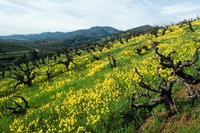 with concentrated, ultra-flavorful juice. With its color and structure boosted by the addition of some Petite Sirah, Old Vine Zinfandel has rich, deep flavors of blackberries, blueberries, pepper and other exotic spice. ($28) with concentrated, ultra-flavorful juice. With its color and structure boosted by the addition of some Petite Sirah, Old Vine Zinfandel has rich, deep flavors of blackberries, blueberries, pepper and other exotic spice. ($28)
The fruit that goes into Somers Ranch Zinfandel actually comes from two separate old vineyards planed on adjacent hilltops. In the 1990s Don Wallace grafted new rootstock on the vines in both blocks. Although the vines are still comparatively young for a heritage vineyard, the wines already show layers of densely packed aromas and flavors. Tasting the 2008 vintage recently, I got vivid suggestions of blueberries and cassis, plus a little smokiness reminiscent of Lapsang Souchong tea. The wine also has a velvety texture and substantial, lingering finish. Because the vineyards are small (two 3-acre parcels), a mere 462 cases of 2008 Somers Ranch Zin was produced. ($34)
Each of the Dry Creek Vineyard Zinfandels has its own personality and subtle expression of individual terroir. What they have in common is extreme vitality supported by a graceful structure. And here’s something else they share: As soon as one of these heritage wines hits the palate it will produce that mysterious rush of emotion familiar to all true Zin lovers. For this, my thanks go out to Kim Stare Wallace for loving Zinfandel enough to fight for the survival and refinement of this this great, good grape.
Posted by Marguerite Thomas at 11:41 AM
|
|
November 4, 2011
My friend Tish, aka William Tisherman, is a New York wine journalist who passionately opposes the use of scores with wine recommendations. We have debated the merits ad nauseum and have agreed to disagree. I use scores, I believe they have value and I do not plan to abandon scores anytime soon. Recently, however, Tish has taken a tact on the use of scores with which I can agree. He is part of a movement in New York City that encourages wine merchants to eschew the published scores from the wine mags in favor of promotional prose that draws upon their own expertise. Recently, however, Tish has taken a tact on the use of scores with which I can agree. He is part of a movement in New York City that encourages wine merchants to eschew the published scores from the wine mags in favor of promotional prose that draws upon their own expertise.
Truth be told, that's how I learned the basics in my earliest years as a wine enthusiast. As a young sportswriter living and working in Manhattan, I visited real brick and mortar wine shops and picked the brains of some of the finest wine merchants in the city. This was some 40 years ago, long before RP and WS, and it was the greatest wine education money could buy.
There's no question something was lost when wine buyers moved away from small, neighborhood wine shops to big-box stores with broader selections and lower prices. If you buy your wines at a grocery store, a giant big-box store such as Costco, or a liquor store, you're not likely to find anyone on staff who can answer your questions about a wine's taste or structure, or recommend a wine to serve at your Saturday night dinner party.
Visit a neighborhood wine merchant and you stand a much better chance of finding just the right wine for you. This is still the best way to buy wine and I applaud Tish for championing the cause.
 But here's the rub: That's not the reality for most wine buyers. In the state of California, where I live now, sales at grocery store chains and the likes of Costco drive the retail wine business. The average person buys wine when they're also out shopping for food. The average person knows what they like when they taste it, but half of them can't remember the name of the wine, the winery or the vintage when you ask them. But here's the rub: That's not the reality for most wine buyers. In the state of California, where I live now, sales at grocery store chains and the likes of Costco drive the retail wine business. The average person buys wine when they're also out shopping for food. The average person knows what they like when they taste it, but half of them can't remember the name of the wine, the winery or the vintage when you ask them.
That's the person who needs the shelf-talker with a useful description of what's in the bottle. If a decent score from a reputable reviewer would help close the deal, the retailer would be foolish not to use it.
I don't understand why some people have a problem with that. There is nothing inherently evil about scoring a wine in a review. Any score I attach to a wine is simply a measure of my enthusiasm for that wine. Think of it as an applause meter. The higher the number, the more I liked it.
Is there something really so bad about that?
Follow Robert on Twitter at @wineguru.
Posted by Robert Whitley at 3:53 PM
|
|
 |
|